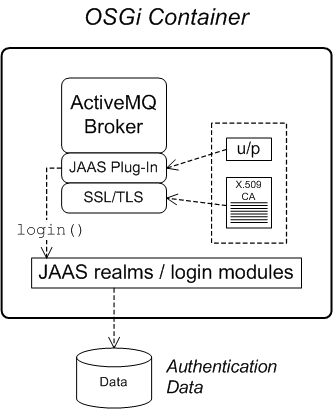1.2. Apache ActiveMQ Security
Overview
Copy linkLink copied to clipboard!
Figure 1.2, “Apache ActiveMQ Security Architecture” shows an overview of the Apache ActiveMQ security architecture. The main security features supported by Apache ActiveMQ are the SSL/TLS security layer and the JAAS security layer. The SSL/TLS security layer provides message encryption and identifies the broker to its clients, while the JAAS security layer identifies clients to the broker.
Figure 1.2. Apache ActiveMQ Security Architecture
SSL/TLS security
Copy linkLink copied to clipboard!
Apache ActiveMQ supports the use of SSL/TLS to secure client-to-broker and broker-to-broker connections, where the underlying SSL/TLS implementation is provided by the Java Secure Socket Extension (JSSE). When deploying brokers and clients in an OSGi container, you cannot configure SSL/TLS security using JSSE system properties, however. You must either use XML configuration (for example, in a Spring or a blueprint file) or set the security properties by programming.
For more details, see Chapter 7, SSL/TLS Security.
JAAS security
Copy linkLink copied to clipboard!
Apache ActiveMQ also supports JAAS security, which typically requires clients to log on to the broker by providing username and password credentials. When deployed in an OSGi container, the broker's JAAS security must be integrated with the container's JAAS security (as described in Section 1.1, “OSGi Container Security”).
